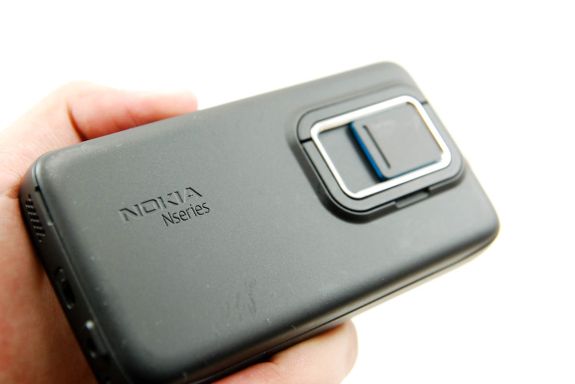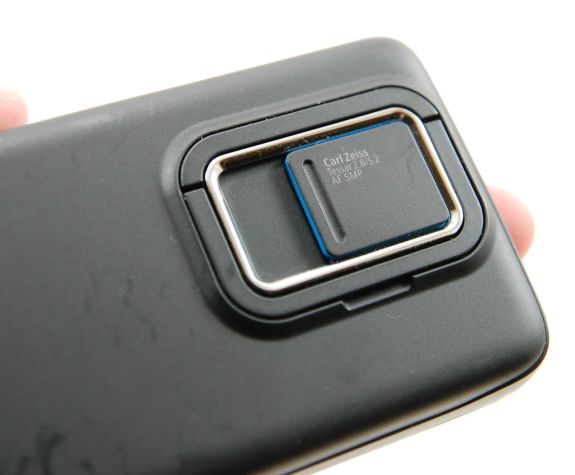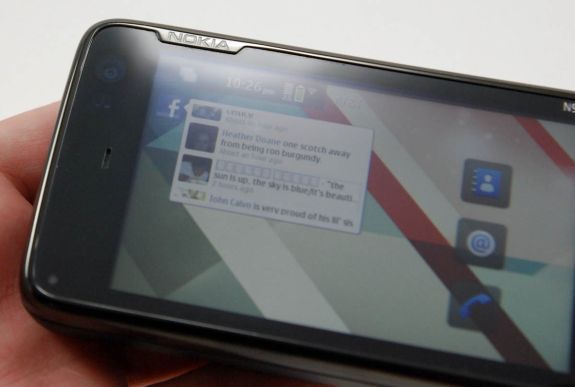Two OMAP 3430 Phones: Nokia N900 and Motorola Droid
by Brian Klug on June 10, 2010 9:29 PM EST- Posted in
- Smartphones
- N900
- Maemo
- Motorola Droid
- Droid
- MeeGo
- Android
- Mobile
The entire backside of the N900 is the removable battery, SIM, and microSD slot cover. It snaps on and snaps off; there's no sliding mechanism, just a small place to get your fingernail under and pry the whole thing off with. That isn't to say that the back isn't snug, it's just a bit unnerving to rip the back off the N900 the first time, but that's really how you do it.
It's also on the back that the sliding camera cover and integrated kickstand reside. The kickstand isn't perfect; since it's off-center if you put the phone down in landscape mode as intended there's a bit of a tendency for the device to tripod on the other side if you tap on the screen. It's clear that this is really meant as an aide to viewing videos, say on a transatlantic flight.
On the front is the resistive topped 800x480 3.5 inch LCD, and up at the very top in the center is the small speaker not much bigger than a grain of rice for making phone calls. I was a bit worried at first that volume would suffer, but it's on par with every other handset I've used. Off to the right of that is the front-facing VGA camera, and on the far left side is the IR proximity sensor.














68 Comments
View All Comments
akse - Friday, June 11, 2010 - link
I've got my N900 clocked to use 250Mhz idle and 805Mhz stress clocks and it fastens everything by huge amount. 600Mhz is sometimes a bit slow and if you up it a little bit, everything starts to get smoother..The custom kernel is using lower voltages but higher clocks than nokia stock kernel.. which is why 805mhz drains just about the same amount of power than 600mhz with stock kernel.
I just love the fact that you can do that kind of things on this phone..
One guy was asking how to backup sms messages.. well there wasn't any app for it so you could just run a command with sqlite in Xterm to search through the database for all sms's and forward the results with > to a text file :)
Exodite - Friday, June 11, 2010 - link
That's a truly epic article, the in-depth look at both the hard- and software side of things is far and above what I'm used to reading regarding smartphone reviews. Many thanks for that!Looking forward to similar articles in the future.
medi01 - Friday, June 11, 2010 - link
Epic, right, and you don't care that Apple's device is visible where it has advantage but is not shown, where it doesn't. Like on contrast comparison images.Misterious.
Exodite - Friday, June 11, 2010 - link
No, can't say I mind that at all really.Then again I'm not in the market for an iPhone anyway.
Brian Klug - Friday, June 11, 2010 - link
I actually completely spaced on that one - I probably had a 3GS in my pocket when I took those photos.There's no conspiracy - I just thought that the Incredible's AMOLED display would make an interesting comparison with the Motorola Droid's LCD, and the N900's resistive layer would mix things up a bit.
The iPhone screen really shows its age in the numbers from the bench though. It leaks light pretty badly and obviously the lower PPI is... well... bad.
Cheers,
Brian
Rayb - Friday, June 11, 2010 - link
Nokia has been making devices that work without much hoopla for a long time. It is not for everyone but it beats the available iPhone in more useful ways than is possible.Helmore - Friday, June 11, 2010 - link
The Adrena 200 is based on the AMD Z430 GPU. A Z340 does not even exist AFAIK.I know, I'm nitpicking here, but I just thought I had to mention it.
The Adreno 200 runs at a frequency of 133 MHz, giving it a theoretical performance of 133 MPixels/s of fill rate and 22 Million Triangle/s. The Adreno 205 is the same core but running at 200 MHz and is what will be used in the MSM7X30 and QSD8X50A (45 nm version of the current Snapdragon chip with some small tweaks). The SGX530 used in the Droid (OMAP3430) runs at around 100 MHz, which should give it a theoretical fill rate of 250 MPixels/s and a 7 million Triangles/s. On the OMAP3630 the SGX530 will run at 200 MHz AFAIK. That's all theoretical performance, as we all know they're only part of the story. Just take a look at the GTX480 and the Radeon 5870 and you'll know that theoretical performance doesn't get you very far.
fabarati - Friday, June 11, 2010 - link
1) there was a mistake on the N900 hardware page: it's a 3.5 mm jack, not a 1.8 mm. You probably mixed it up with 1/8"2) The N900 can do Video calling over 3G, like most 3G phones in Europe have done since 2003. It works ok, but it's hella expensive, so no one does it more than once or twice.
Brian Klug - Friday, June 11, 2010 - link
Fixed! Thanks!-Brian
wobblysausage - Tuesday, June 15, 2010 - link
Lies! It cannot make a 3g video call.It can make a skype video call (or a google chat video call) over a 3g data connection but this is not the same thing. Not nearly.
I've had my N900 since November and this is the 1 thing I really miss.